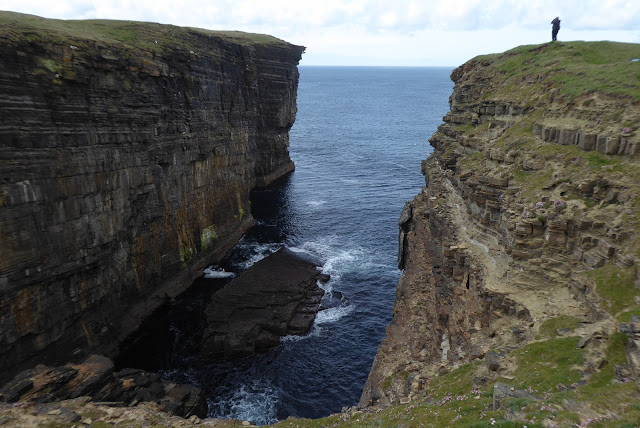On Sunday I helped out with a recce of a walk near the Bay of Skaill. This area is famous as the location of Skara Brae, the 5000 year old Neolithic village, but we were more interested in the current flora and fauna along and around the clifftops.
The coastline is cleft with many geos (pronounced with a hard 'G'), which offer nesting sites for all manner of birdlife, principally auks and Fulmars, but with the occasional corvid like this Hooded Crow.
1. Some are tasty and don't kill you;
2. Some are tasty and... oh, man, wow... cool!;
3. Some are tasty but cure you of ever needing to eat ever again.
Suffice it to say, mushrooms have an aura of mystery. Couple that with the fact that some grow in a circle, and of those circles, some create soil conditions for the grass within the circle to be rather lush, like in the above photo, then I'd say that might set a body to wondering about the power of mushrooms and circles. I'm not theorising that this is why humans build stone circles, to contain the power and conduct secretive rituals therein, but the mushrooms may have played a part in that idea. I mean, apart from just the ingesting of the second type of mushrooms! And, no, I haven't.
In places, the clifftops are bereft of vegetation and soil, a consequence of the harsh climate and storm surges, but this allows us to look at the many sedimentary layers which comprise much of the bedrock of Orkney. Here are a few examples of the different layers of Old Red Sandstone from the Devonian Age (about 400 million years ago) including fossil mud cracks and fossil ripples of varying sizes.

A little further back from the cliff edge, the vegetation tends to be maritime heath. At this time of year, the flora is mainly Thrift, Common Scurvygrass, Bird's-foot Trefoil and Spring Squill.
 |
| Spring Squill |
Returning Arctic Skuas have arrived back from the southern hemisphere to breed, following the Arctic Terns upon whom they klepto-parasitise (steal their food). In the below photo, a passing Skua glides over swathes of Spring Squill.
From a distance, I was able to zoom in on a few birds sat on the ground, who in turn were watching waders, gulls and terns which were roosting nearby. Whenever a Skua took off to fly around, all the waders, gulls and terns would mob them in a cloud of alarm calls and frantic aerobatics. Not so peaceable!








Comments
Post a Comment